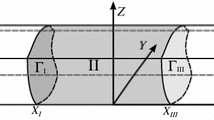The shift equations iteration (SEI) solves the n-level quantum scattering problem in one dimension, i.e., the close-coupled equations, free from exponential instability arising from closed channels. SEI provides exponential-instability-free transmission and reflection coefficients, and is well suited to two-sided scattering problems such as conduction in molecular wires. Our most efficient implementation of SEI utilizes an adaptation of the log-derivative symplectic integrator described by Manolopoulos and Gray in (J Chem Phys 102:9214, 1995). The two-level nonadiabatic tunneling system is investigated—in the tunneling regime, above the barrier, and at resonance. Nonadiabatic components in the upper channel wavefunction (and lower channel wavefunction at resonance energies) are found to be non-adiabatic, i.e., not describable by WKB functions. Their behavior is characterized in terms of an empirical model relating these components to adiabatic components in the lower (upper) channel and the potential energy coupling.
Similar content being viewed by others
References
Nyman G and Yu H-G (2000). Rep Prog Phys 63: 1001
Laing JR, George TF (1977) Phys Rev A 16:1082 and references therein
Walker RB and Light JC (1976). J Chem Phys 64: 4272
Stechel EB, Walker RB and Light JC (1978). J Chem Phys 69: 3518
Alexander MH and Manolopoulos DE (1987). J Chem Phys 86: 2044
Alexander MH, Parlant G and Hemmer TH (1989). J Chem Phys 91: 2388
Johnson B (1973). J Comput Phys 13: 445
Mrugala F and Secrest D (1983). J Chem Phys 78: 5954
Mrugala F and Secrest D (1983). J Chem Phys 79: 5960
Manolopoulos DE (1986). J Chem Phys 85: 6425
Child MS (1996). Molecular collision theory. Dover, Mineola
Bac̆ić Z, Kress JD, Parker GA and Pack RT (1990). J Chem Phys 92: 2344
Bodo E, Gianturco FA and Dalgarno A (2002). J Chem Phys 116: 9222
Manolopoulos DE (1997). J Chem Soc Faraday Trans 93: 673
Echave J (1996). J Chem Phys 104: 1380
Abrashkevich DG and Brumer P (2001). J Chem Phys 114: 54
Gianturco FA and Materzanini G (1999). Phys Rev A 60: 1165
Heath JR and Ratner MA (2003). Phys Today 56: 43
Nitzan A and Ratner MA (2003). Science 300: 1384
Sánchez CG, Stamenova M, Sanvito S, Bowler DR, Horsfield AP and Todorov TN (2006). J Chem Phys 124: 214708–1
Li J and Wang L-W (2005). Phys Rev B 72: 125325
Landauer R (1957). IBM J Res Dev 1: 223
Nitzan A (2001). Annu Rev Phys Chem 52: 681
Lam SWK, Dumont RS (unpublished work)
Manolopoulos DE and Gray SK (1995). J Chem Phys 102: 9214
McLachlan RI and Atela P (1991). Nonlinearity 5: 541
Zhu C and Nakamura H (1994). J Chem Phys 101: 10630
Zhu C and Nakamura H (1993). J Chem Phys 98: 6208
Nakamura H (2002). Nonadiabatic transition. World Scientific, Singapore
Dumont RS and Pechukas P (1988). J Chem Phys 89: 5764
von Neumann J and Wigner E (1929). Phys Z 30: 467
Eu BC (1984). Semiclassical theories of molecular scattering. Springer-Verlag, Berlin
Reed M and Simon B (1980). Methods of modern mathematical physics I: functional analysis. Academic, New York
Feschbach H (1958). Ann Phys (NY) 5: 363
Feschbach H and Nenciu G (1991). Rev Mod Phys 63: 91
Dumont RS (2002). J Chem Phys 116: 9158
Fano U (1961). Phys Rev 124: 1866
Fano U and Rau ARP (1986). Atomic collision and spectra. Academic, Orlando
Voo K-K, Chu CS (2005) Phys Rev B 72:165307 and references therein
Veenstra CN, van Dijk W, Sprung DWL, Martorell J, arxiv:cond-mat/0411118
Dumont RS, Lam SWK, unpublished work
Ridley EC (1957). Proc Camb Phil Soc 53: 442
Author information
Authors and Affiliations
Corresponding author
Rights and permissions
About this article
Cite this article
Dumont, R.S., Lam, S.W.K. Shift equations iteration solution to n-level close coupled equations, and the two-level nonadiabatic tunneling problem revisited. Theor Chem Account 119, 383–405 (2008). https://doi.org/10.1007/s00214-007-0395-2
Received:
Published:
Issue Date:
DOI: https://doi.org/10.1007/s00214-007-0395-2




